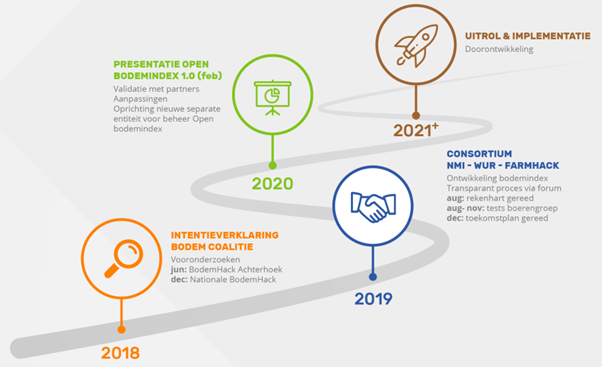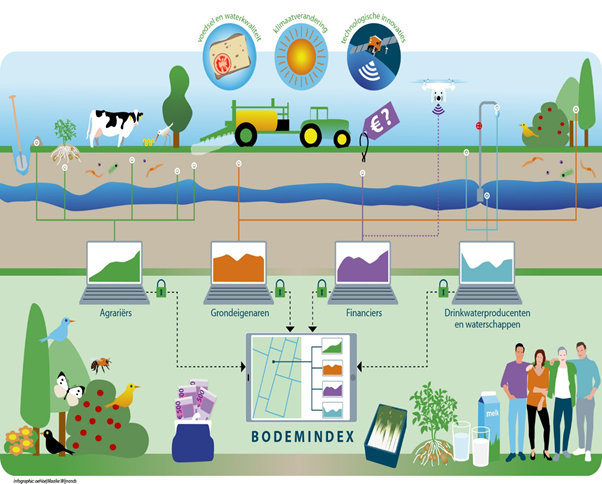INNOVATION EXPLAINED
The Open Soil Index (Dutch 'Open Bodem Index'; OBI) is an initiative of three different partners, Rabobank (one of the biggest banks in the Netherlands), a.s.r (a big insurance company), and Vitens (a water winning company). Together with research institutes, consultancy companies and soil experts they developed this soil assessment framework. Based on soil measurements (available from routine tests) and field properties, an index is determined for each agricultural field. This index tells something more about the quality today and how it can be improved.
The OBI score ranges from 0-10, which gives a value that can be monitored over time and be compared with other fields. This score can be decomposed in different sub scores related to different soil aspects (chemical, physical, biological or management). All relevant aspects are included, as well as soil life, soil structure, location of the field, and landscape characteristics. Input needed: analysed soil properties (routine samples), field properties (available), and soil management measures (e.g. crop rotation, ploughing and catch crops).
Since march 2021, the OBI is in the hands of an independent foundation, so the data will not end up in the hands of market parties. The goal is to link a reward to the OBI-score, however until today it is not decided how this will be rolled out. As three different companies founded this tool, probably three different rewards systems will be developed.

History of the Open Soil Index
IMPACT ON FARM PERFORMANCES
Socio-economic resilience
- The calculation of the OBI is free for every farmer. Only the measurements done systematically will stay a cost for the farmer.
Animal health and welfare
Production efficiency and meat quality
Environmental sustainability
- With the output, the farmer gets an idea of extra measures to take to improve soil quality and lower emissions
DETAILED INFORMATION FROM WEBSITE
In order to manage soil quality well, it is necessary to concretise the concept of 'sustainable soil management'. After all, soil can be used for all sorts of purposes. Within the current Open Soil Index, the starting point is that the soil should be managed so as to ensure sustainable agricultural production. In concrete terms, this means that the soil is evaluated in terms of the desire to continue the cultivation plan of the past ten years. The soil is managed sustainably, in the sense that the soil quality facilitates maximum crop production and is (and remains) sufficient to facilitate crop production in the future. Sustainable also means that the agricultural use of the soil goes hand in hand with minimal losses to groundwater and surface water. In the future (after 2019) the OBI can also be used to provide insight into the contribution of the soil to the social tasks for biodiversity and climate, but quantification of these tasks has no priority in 2019.

Overview Open Soil Index
Within the constraints of context (continuation of crop rotation) and objective (sustainable agricultural production), the quality of the soil is mapped on the basis of routinely available soil analyses, field characteristics and remote sensing data. The soil properties are used, on the basis of agricultural research and in conjunction with each other, to quantify a whole set of soil functions. These functions can be clustered around the three relevant aspects of soil, namely i) chemistry and nutrient supply, ii) structure and rooting and iii) biology and disease resistance. Separate from these three aspects - each of which relies heavily on actual measurements - soil management is also evaluated.
In order to evaluate the soil management, a link is made to the developed Sustainable Soil Management label. This Label Sustainable Soil Management was designed in 2016 at ASR's request by CLM Research & Advice, in cooperation with other soil experts from Dutch research institutes, laboratories and consulting firms. Indeed, sustainable soil management is an important prerequisite for maintaining the value of the land. Soil quality reflects the condition of the soil to function as a resilient ecosystem that can support plants, people and animals. With a team of soil experts from research and practice, a selection was made of measurable and verifiable soil management measures that contribute to the soil ecosystem functions. A distinction was made between the arable and dairy farming sectors and the various soil types. These measures have been selected by the soil experts and assessed in relation to their impact on soil quality.
Within the management, explicit attention is paid to organic matter, as an important driver of soil fertility. Because changes in the organic matter content are difficult to measure, an estimate is made of the net inflow or outflow of Effective Organic Matter on the basis of the crop rotation plan - and the assumption that the space for use is filled with animal manure. This balance is indicative for the expected developments in the organic matter content of the soil.
Once the various soil functions have been quantified, this helps the farmer to understand the differences between his fields. It improves soil quality because a targeted approach can be taken to maintain or improve soil quality. To support this last step, the calculated soil functions (each with their own unit) are evaluated and translated into a uniform and clear system whereby the relevance of this soil function is converted into a score between zero and one hundred. In order to make this translation, use is made of existing data sets and field experiments with which the relevance of a soil function for crop production (or quality) can be substantiated quantitatively. This conversion into a uniform value score - the indicator - will enable agricultural entrepreneurs to show others the positive contribution they are making to a sustainable world and thus convert their efforts into extra income.
Once a soil index is also available for each soil function, this can be translated into an integral assessment of the soil as a whole. This integration takes explicit account of current and desired (or achievable) soil quality. This also means that the desired situation takes account of soil type and use. It is not yet clear how and in what way crop differentiation within the crop rotation plan and environmental versus agricultural objectives can and may influence integration.
Finally, recommendations are given per soil function for management measures that can be implemented to improve soil quality. To this end, measures are inventoried on the basis of scientific literature in relation to their impact on soil functions or soil indicators. If it appears that soil quality can be improved on various aspects, the most relevant measure is recommended.
Link to the website (Dutch)